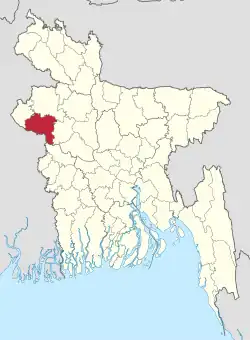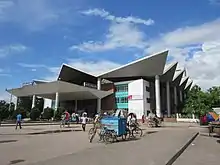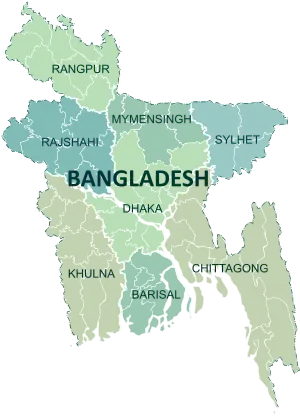Rajshahi District
রাজশাহী জেলা | |
|---|---|
| Rajshahi District | |
     Clockwise from top-left: Aerial view of Rajshahi, Kismat Maria Mosque, Rajshahi College, Padma River near Rajshahi, Puthia Rajbari | |
 Location of Rajshahi District in Bangladesh | |
Expandable map of Rajshahi District | |
| Coordinates: 24°24′N 88°30′E / 24.40°N 88.50°E | |
| Country | |
| Division | Rajshahi Division |
| Government | |
| • Deputy Commissioner | Abdul Jalil |
| • District Council Chairman | Muhammad Ali Sarkar [1] |
| • Chief Executive Officer | A. B. M. Sharif Uddin |
| Area | |
| • Total | 2,407.01 km2 (929.35 sq mi) |
| Population (2022 census)[2] | |
| • Total | 2,909,622 |
| • Density | 4,100/km2 (11,000/sq mi) |
| Time zone | UTC+06:00 (BST) |
| HDI (2019) | 0.642[3] medium · 6th of 20 |
| Website | rajshahi |
Rajshahi District (Bengali: রাজশাহী জেলা) is a district in mid-western Bangladesh. It is a part of the Rajshahi Division.[4] The metropolitan city of Rajshahi is in Rajshahi District.
Geography
Rajshahi District is bounded by Naogaon District to the north, Natore District to the east, Chapai Nababganj District to west and a small part of Kushtia District and the river Padma to the south. The district consists of alluvial plain.
Rivers
There are ten rivers in this district, totaling 146 km in length. The main river is the Padma (Ganges). Other rivers include Mahananda, Baral and Barnai.
History
The Mughal Emperor Akbar gave the Rajshahi region to the Puṭhia Raj family to govern. The governor was Pitambar.
In 1772, the Rajshahi District was established. Parts of it eventually became the districts of Bogura, Malda, Natore, Naogaon, Nawabganj, and Pabna. On 1 April 1876, Rajshahi town was made into the municipal town.
During the Bangladesh Liberation War in 1971, the town was the site of battles between the Mukti Bahini and the Pakistan Army. Between 26 and 30 March, Pakistan's forces killed 31 people in Godagaɽi upazila. A battle on 30 March resulted in the death of an East Pakistan Rifles member. On 13 April, the Pakistan army killed Rajshahi Cadet College Professor AB Siddiqi. On 24 May, it attacked Tahirpur Haṭ in Bagmara upazila, killing 25 people. Mukti Bahini commander Havilder Shafiq led an attack on a Pakistani boat on 8 August, killing 18 personnel. Pakistan then killed two members of Bangladesh Ansar and established a camp in the Zoha Hall of Rajshahi University, where they massacred hundreds of civilians. The Pakistan army also established camps inside Rajshahi Cadet College, Roy Saheb brickfield, Sardaha Pilot School, and Sardah Police Academy. It tortured members of Mukti Bahini and civilians in the camps, and killed hundreds of refugees on the banks of the Padma river who were fleeing to India. In a battle between Mukti Bahini and Pakistan near Kabasmul, a Pakistani army major was killed. Pakistan retaliated by killing 44 civilians in Gaganbari and Palsa.[4] On 17 December, Pakistan surrendered to the Indian Army Captain Nanda in Naṭore, a day after its forces signed the Pakistani instrument of Surrender in Dhaka. Its camp in Rajshahi University was taken over by Mukti Bahini members On 18 December, the Pakistan army stationed in Pabna and Rajshahi districts surrendered. Surrender ceremonies took place on 20 December.[5]
Rajshahi town was upgraded to a municipal corporation on 13 August 1987. In 1997, the government of Bangladesh made the town into a full city corporation, Rajshahi City Corporation.[4] In 2016, Rezaul Karim Siddiquee, a professor at University of Rajshahi, and a 65 year old Sufi preacher, Shahidullah, were killed by Islamic extremists.[6]
Demographics
| Year | Pop. | ±% p.a. |
|---|---|---|
| 1981 | 1,540,085 | — |
| 1991 | 1,887,015 | +2.05% |
| 2001 | 2,286,874 | +1.94% |
| 2011 | 2,595,197 | +1.27% |
| 2022 | 2,909,622 | +1.05% |
| Sources:[2][7] | ||
According to the 2022 Census of Bangladesh, Rajshahi District had 775,260 households and a population of 2,909,622, 37.6% of whom lived in urban areas. The population density was 4,100 people per km2. The literacy rate (age 7 and over) was 75.1%, compared to the national average of 74.7%.[2]
| Religion | Population (1941)[8]: 88–89 | Percentage (1941) | Population (2011)[7] | Percentage (2011) |
|---|---|---|---|---|
| Islam |
435,829 | 75.18% | 2,430,194 | 93.64% |
| Hinduism |
111,991 | 19.32% | 122,394 | 4.72% |
| Tribal religion |
31,439 | 5.42% | 14,645 | 0.56% |
| Christianity |
216 | 0.04% | 27,830 | 1.07% |
| Others [lower-alpha 2] | 258 | 0.04% | 134 | 0.01% |
| Total Population | 579,733 | 100% | 2,595,197 | 100% |
Muslims are the majority population. The Christian population has grown quickly, while the number of those following ethnic religions has declined significantly. Ethnic minorities were 49,312 (1.90%), mainly Santals and Oraons.[7]
Upazilas
Sub-district or upazilas and thanas of Rajshahi are[4]
- Bagha Upazila
- Bagmara Upazila
- Charghat Upazila
- Durgapur Upazila
- Godagari Upazila
- Mohanpur Upazila
- Paba Upazila
- Puthia Upazila
- Tanore Upazila
- Boalia Thana
- Matihar Thana
- Rajpara Thana
- Shah Makdam Thana
- Chandrima Thana
- Katakhali Thana
- Belpukur Thana
- Airport Thana
- Kashiadanga Thana
- Kornohar Thana
- Damkura Thana
Communications

Rajshahi district has well organized internal communication as well as connection to other parts of Bangladesh. There are 96 metalled roads with a total length of about 1270 km, 108 semi-metalled roads of about 546 km length, and six railways of about 63 km total length.
Media and press club
There are many Bengali daily newspapers published from the city, including Sonali Sangbad, Sunshine, Dainik Barta, Sonar Desh, Natun Provat, and Amader Rajshahi.[9] There are also many online news portal such as rajshahinews24.com, silkcitynews.com, Uttorbongo Protidin and GKhobor.
The government-run Bangladesh Television and Bangladesh Betar have transmission centres in Rajshahi.
A local FM radio station, Radio Padma, transmits at 99.2 MHz frequency. Radio Foorti transmits at 88.0 MHz.
Rajshahi City, Rajshahi, Rajshahi Metropolitan and Rajshahi Model press clubs are based in the city.
Economy
Rajshahi Metropolitan is widely known as Silk City of Bangladesh, the Bangladesh Sericulture Development Board (In Bengali : Jatio Resham Board) is situated at Rajshahi. There are seven silk factories in the BSCIC Industrial Town in Rajshahi.[10] An inter-city train is named Silk City Express after Rajshahi; it serves the route between Rajshahi and Dhaka.[11] Rajshahi is also notable for producing mangos and silk.[12]
Points of interest
- Bagdhani Mosque
- Bagha Mosque
- Kismat Maria Mosque
- Tomb of Shah Makhdum
- Tomb of Shah Sultan
- Talando Shiv Mandir
- Puthia Temple Complex
- Boro Kuthi
See also
Notes
- ↑ Sadar subdivision of Rajshahi district
- ↑ Including Jainism, Buddhism, Zoroastrianism, Judaism, Ad-Dharmis, or not stated
References
- ↑ "Chairman-Institute of Business Administration".
- 1 2 3 Population and Housing Census 2022: Preliminary Report. Bangladesh Bureau of Statistics. August 2022. pp. viii, 28, 30, 39, 44, 46. ISBN 978-984-35-2977-0.
- ↑ "Sub-national HDI - Area Database - Global Data Lab". hdi.globaldatalab.org. Retrieved 19 June 2020.
- 1 2 3 4 Mahbubar Rahman, Md. (2012). "Rajshahi District". In Islam, Sirajul; Jamal, Ahmed A. (eds.). Banglapedia: National Encyclopedia of Bangladesh (Second ed.). Asiatic Society of Bangladesh.
- ↑ "Pabna, Rajshahi were freed two days after final victory". The Daily Star. 18 December 2013. Retrieved 7 January 2018.
- ↑ "'Pir' killed in Rajshahi". The Daily Star. 8 May 2016. Retrieved 7 January 2018.
- 1 2 3 4 "Bangladesh Population and Housing Census 2011 Zila Report – Rajshahi" (PDF). Bangladesh Bureau of Statistics.
- ↑ "Census of India, 1941 Volume VI Bengal Province" (PDF).
- ↑ পত্র-পত্রিকা (in Bengali).
- ↑ "Rajshahi Silk Losing Shine". The Daily Star. 13 June 2011. Retrieved 7 January 2018.
- ↑ "Silk City Express". The Daily Star. 26 December 2008. Retrieved 7 January 2018.
- ↑ "It's mango time in Rajshahi". The Daily Star. 21 June 2016. Retrieved 7 January 2018.
